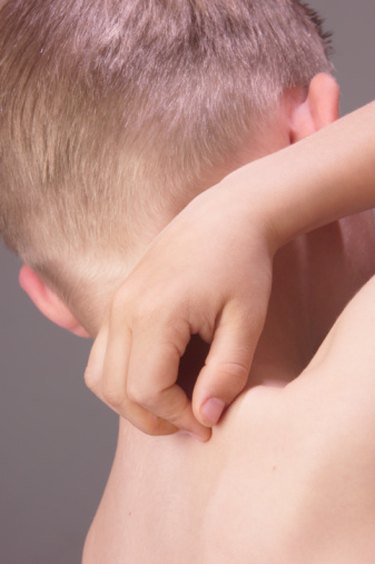
A rash on your upper body can be due to a number of conditions. You should always have any rash checked by a doctor, especially if it does not go away after a few days. If your rash is accompanied by a fever or difficulty breathing or if it turns into fluid-filled blisters, consult a medical professional immediately.
Symptoms
Video of the Day
According to the New York Times Health Guide, a rash involves changes in the color or texture of your skin. Often a rash will include inflammation, itching and, in some cases, scaling or oozing blisters. A rash on your upper body will usually not include symptoms below the waist but affects mainly your chest, back, arms, neck, face or scalp.
Video of the Day
Causes
According to the National Institutes of Health, the most common cause of a rash on your upper body is dermatitis, which simply means an inflammation of the skin. Contact dermatitis is caused by allowing your skin to come into contact with a substance that causes irritation, such as cosmetics, chemicals, dyes and plants like poison oak. Often the culprit is a laundry detergent, soap, shampoo or lotion. Some fabric, like wool or other animal hair, can also cause a rash to appear.
Seborrheic dermatitis can appear on your upper body as a red, scaly, itchy rash. The exact cause of seborrheic dermatitis is not known, but according to Mayo Clinic, stress, change of seasons, some neurological conditions and a yeast infection may contribute to this condition.
Dermatitis herpetiformis often starts out as tiny, water-filled blisters that can occur on your upper body as well as other locations. It is characterized by intense stinging, burning and itching and is usually caused by an allergy to gluten, a protein found in some grain products.
Eczema can also cause a red, itchy rash. It is often found in crevices such as elbows and behind knees, but can also affect your armpits, the area behind your ears and portions of your neck. It is often found in people with allergies or asthma.
Viruses such as shingles, measles and chicken pox can all appear as a rash on your upper body but may appear on your lower body as well.
Treatments
Treatment for a rash on your upper body will vary depending on the cause. According to the National Institutes of Health, the best treatment for contact dermatitis is to gently wash the area, pat dry and apply either calamine lotion or hydrocortisone cream or ointment. It is best to avoid scrubbing or scratching your skin. In severe cases, such as systemic poison oak, oral medications may be helpful.
According to Mayo Clinic, treatment for sebborheic dermatitis includes eliminating the cause and using over-the-counter anti-fungal and anti-itch creams.
According to the American Osteopathic College of Dermatology, eliminating gluten from your diet can help eliminate dermatitis herpetiformis.
Eczema can be treated with moisturizers and soothing oatmeal bath products.
Antiviral medications may be helpful with shingles if taken within 72 hours of the initial outbreak.
Prevention
Avoiding the allergens that cause dermatitis, dermatitis herpetiformis and eczema will help prevent a rash. Vaccinations can help prevent shingles, measles and chicken pox. Yoga or other forms of relaxation can help prevent stress-related rashes.
Emergencies
In some cases, a rash can signal a medical emergency. Anaphylactic shock can result from an allergic reactions that includes wheezing, itching and hives. If not treated immediately, anaphylaxis can lead to coma or death. If you suspect anaphylaxis, get to an emergency room or call 911.
Is this an emergency? If you are experiencing serious medical symptoms, please see the National Library of Medicine’s list of signs you need emergency medical attention or call 911.